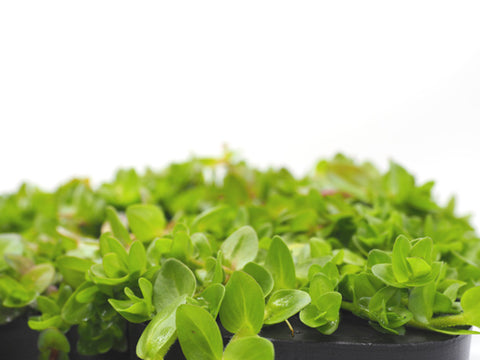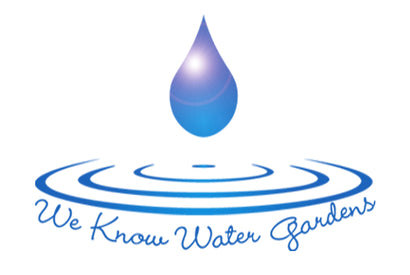The Ultimate Guide to Water Hyssop: Why You Should Grow Bacopa Caroliniana in your Aussie Pond

Water Hyssop Bacopa Carolina is the perfect aquatic plant to add a touch of elegance and tranquility to your water feature. Not only is this pond plant a great choice as a floating, creeping pond plant, it has a lemon scent when the leaves are crushed! It canbe grown above or below the pond water but more on this later.
Bacopa Caroliniana, sometimes known as water hyssop, blue water hyssop and lemon bacopa, is a versatile plant native to North America. Its lush green leaves and delicate white flowers not only create a visually appealing display but also offer environmental benefits for your pond.
In this article, we will present to you some great reasons why you should consider growing Bacopa Caroliniana in your Aussie backyard pond or water garden. We will look at this pond plants characteristics, care requirements, and advantages it brings to your aquatic ecosystem. Whether you are a seasoned gardener or a beginner, this guide will provide you with the knowledge and tips you need to successfully cultivate and maintain Bacopa Carolina in your pond.
Benefits of growing Water Hyssop Bacopa Caroliniana in Australian ponds.
First and foremost, Bacopa Caroliniana enhances the aesthetic appeal of your pond. Its vibrant green leaves and dainty blue flowers create a beautiful contrast against the backdrop of water. Whether you have a small backyard pond or a larger water garden, Bacopa Carolina can be grown to float across the surface of your pond or you can grow it submerged to a depth of 20cm where it acts as a natural oxygenating pond plant.
In addition to its visual appeal, Bacopa Caroliniana plays a crucial role in maintaining the ecological balance of your pond. This aquatic plant helps to oxygenate the water (when grown submerged), providing a healthier environment for fish and other aquatic life. Nutrients including nitrates and phosphates are the major cause of algae in a pond. So, if you want to get rid of algae, then Water Hyssop is a water plant that you must have!
Furthermore, Bacopa Caroliniana serves as a natural habitat and food source for various aquatic organisms. The dense foliage of this plant provides shelter and spawning grounds for small fish and invertebrates, contributing to a thriving and diverse ecosystem. Additionally, the leaves of Caroliniana can be consumed by certain species of fish, serving as a nutritious supplement to their diet.
By growing Bacopa Caroliniana in your Aussie pond, you not only enhance its visual appeal but also contribute to the ecological balance and well-being of your aquatic ecosystem. This versatile plant offers numerous benefits that make it a worthwhile addition to any pond.
How to grow Water Hyssop Bacopa Caroliniana in your pond
 Now that you understand the benefits of growing Bacopa Caroliniana, let's look at how to grow this aquatic plant in your Aussie pond.
Now that you understand the benefits of growing Bacopa Caroliniana, let's look at how to grow this aquatic plant in your Aussie pond.
- Choosing the right location: Bacopa Caroliniana thrives in full sun to partial shade conditions. When selecting the location for your pond, ensure that it receives adequate sunlight for at least 4-6 hours a day. It's important to strike a balance between sunlight and shade to prevent excessive algae growth.
- Preparing the soil: Bacopa Caroliniana prefers a rich, loamy soil. Before planting, prepare the soil by removing any debris, rocks, or weeds. If your pond has a liner you can grow it in our floating pond plant rings or place the pot to a depth of 20cm in your pond.
- Planting the Bacopa Caroliniana: Gently remove the Bacopa Caroliniana from its container and loosen the roots. Place the plant in the prepared soil or planting pocket, ensuring that the crown of the plant sits just above the soil level. Backfill the hole with soil, gently pressing it down to secure the plant in place. If using a pond plant basket, place it in the water at the desired depth. You can weigh this down using some river pebbles to keep it in position.
- Feeding: Bacopa Caroliniana benefits from regular feeding to promote healthy growth and flowering. Use a slow-release aquatic fertilizer or a specifically formulated for aquatic plants. Follow the manufacturer's instructions for application rates and frequency.
By following these steps, you can successfully grow Bacopa Caroliniana in your Aussie pond and enjoy its many benefits. Remember to monitor the plant's growth and make any necessary adjustments to ensure its health and vitality.
Aussie pond and enjoy its many benefits. Remember to monitor the plant's growth and make any necessary adjustments to ensure its health and vitality.
Maintenance and care tips for Bacopa Caroliniana
While Bacopa Caroliniana is a relatively low-maintenance plant, there are certain care tips you should keep in mind to ensure its optimal growth and longevity in your pond.
- Pruning: Regular pruning is essential to maintain the desired shape and size of Bacopa Caroliniana. Trim back any overgrown or yellowing leaves to promote new growth and maintain the plant's aesthetic appeal. Pruning also helps to prevent overcrowding and ensures that the plant receives adequate airflow and sunlight.
- Dividing: Over time, Bacopa Carolina may become overcrowded and form dense clumps. To prevent this, divide the plant every 2-3 years. Carefully remove the plant from the pond and separate the root clumps into smaller sections. Replant the divided sections, ensuring that each division has sufficient roots and foliage. This process helps to rejuvenate the plant and promote healthier growth.
- Pest and disease control: Bacopa Caroliniana is generally resistant to pests and diseases. However, occasional infestations may occur, particularly by aphids or snails. Monitor your plants regularly and take appropriate action if you notice any signs of pest damage. Use organic or chemical-based pest control methods as needed, following the instructions provided.
- Winter care: In regions of Australia with colder climates, Bacopa Caroliniana may not be able to survive the winter months. If you live in such an area, consider treating Bacopa Carolina as an annual or bring it indoors during the colder months. Alternatively, you can place the plant in a deeper part of the pond where it can overwinter, provided the pond does not freeze completely.
By following these maintenance and care tips, you can ensure the health and longevity of Bacopa Caroliniana in your pond. Regular monitoring and proper care will help you enjoy the full benefits of this beautiful aquatic plant.
Growing Bacopa Caroliniana for Natural Water Filtration and Oxygenation
 Bacopa Caroliniana is not only a stunning pond plant to grow but also a valuable asset for natural water filtration and oxygenation. Its ability to absorb excess nutrients and release oxygen makes it an essential plant for maintaining a healthy aquatic ecosystem.
Bacopa Caroliniana is not only a stunning pond plant to grow but also a valuable asset for natural water filtration and oxygenation. Its ability to absorb excess nutrients and release oxygen makes it an essential plant for maintaining a healthy aquatic ecosystem.
One of the primary benefits of Bacopa Caroliniana is its role in reducing algae growth. Algae are notorious for causing green water and unsightly blooms in ponds. However, Bacopa Caroliniana competes with algae for nutrients, effectively limiting their growth. By incorporating this plant into your pond, you can naturally control and prevent algae problems, resulting in clearer, cleaner water.
In addition to its nutrient-absorbing properties, Bacopa Caroliniana also plays a crucial role in oxygenating the water. The oxygenation process is vital for maintaining a balanced ecosystem, especially for fish and other aquatic organisms that require oxygen to thrive. By introducing Bacopa Carolina to your pond, you are not only beautifying it but also providing a healthier habitat for your aquatic inhabitants.
Not only does Bacopa Caroliniana contribute to water quality and oxygenation, but it also provides shelter and shade for aquatic life. The dense foliage of this plant offers hiding spots for fish and other small creatures, protecting them from predators and providing a sense of security. Moreover, the shade provided by Bacopa Carolina helps in reducing sunlight exposure, thereby reducing the risk of excessive evaporation and maintaining a stable water temperature. Overall, Bacopa Carolina promotes a more balanced and sustainable ecosystem within your pond.
The small blue flowers that appear each spring and summer play a key role in attracting the smallest of beneficial pollinators to our gardens. Its ability to filter water, oxygenate the environment, and provide shelter make it an invaluable addition to any aquatic landscape. In the next section, we will explore the care requirements for Bacopa Carolina to ensure its optimal growth and longevity in your pond.
Common Pests and Diseases of Bacopa Caroliniana and How to Combat Them
While Bacopa Caroliniana is generally resistant to pests and diseases, it is not entirely immune. Certain pests and diseases can cause damage and hinder the plant's growth if left unchecked. Understanding these potential threats and implementing preventive measures can help you maintain a healthy and vibrant Bacopa Carolina in your pond.
1. Aphids: Aphids are small, soft-bodied insects that feed on the sap of plants, causing stunted growth and distorted leaves. To control aphids on Bacopa Caroliniana, you can introduce natural predators such as ladybugs or use insecticidal soaps or oils. Regularly inspect the plant for signs of aphid infestation, including curled leaves and sticky residue, and take immediate action to prevent further damage.
2. Snails and Slugs: Snails and slugs are common pests that can munch on the leaves of Bacopa Caroliniana, leaving behind ragged edges and holes. To deter these pests, you can manually remove them from the plant or introduce natural predators like ducks or certain fish species that feed on snails and slugs. Creating barriers, such as copper tape or diatomaceous earth, around the plant can also be effective in preventing their access.
3. Nutrient Deficiencies: Inadequate nutrient levels can lead to poor growth and yellowing of Bacopa Caroliniana leaves. Regularly monitor the plant for signs of nutrient deficiencies, such as pale or discolored foliage. Adjust the nutrient levels in your pond using appropriate pond plant food to ensure the plant receives essential nutrients for healthy growth.
By being vigilant and taking proactive measures against pests, diseases, and nutrient deficiencies, you can ensure the long-term health and vitality of Bacopa Caroliniana in your Aussie pond. Regular monitoring, prompt action, and a well-maintained pond environment are key to preventing and combating potential threats.
Hopefully we have convinced you to grow Water Hyssop Bacopa Caroliniana in your pond, water garden or pond. It really is a great choice, one that will benefit your pond in so many ways. Happy gardening!
© weknowwatergardens 2024



